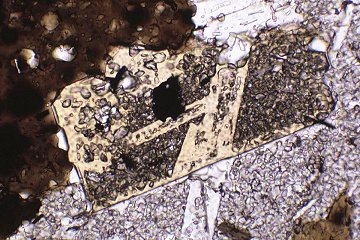Microstructures of prograde mineral growth in the Bushveld aureole
This page contains supplementary material for the paper Assessing the extent of disequilibrium and overstepping of prograde metamorphic reactions in metapelites from the Bushveld Complex aureole, South Africa, by D J Waters and D.P. Lovegrove. The paper was presented at the Ron Vernon Symposium, Congress of the Geological Society of Australia, Sydney, July 2000, and published in the Journal of Metamorphic Geology, vol. 20, pp. 135-149 in January 2002. To access the full paper, use this link (Wiley Online Library).
Abstract
Andalusite-staurolite-biotite hornfels metamorphosed beneath the mafic layered rocks of the Bushveld Complex, South Africa, preserves a detailed record of the relative timing of porphyroblast growth and metamorphic reactions. The sequence inferred from microstructures shows considerable overlap of the period of growth of porphyroblasts of staurolite, cordierite, biotite and andalusite, and the persistence over a similar interval of the reactant porphyroblastic phase chloritoid. This is inconsistent with calculations of equilibrium phase relations, and implies that disequilibrium processes controlled the prograde reaction sequence, despite the slow heating rates involved (1°C per 10,000 years). The early appearance of cordierite by a metastable reaction and its subsequent disappearance indicates that delayed nucleation of porphyroblastic phases, rather than simply sluggish reaction, is required to account for the sequence of growth. The predicted reactions for the first appearance of andalusite and staurolite have low entropy of reaction, and do not occur until they have been overtaken in terms of reaction affinity by high-entropy devolatilisation reactions involving the breakdown of chlorite. Once the porphyroblasts have nucleated, metastable chloritoid-breakdown reactions also contribute to their growth. The implied magnitude of the critical overstepping for andalusite nucleation is around 5 kJ/mole (equivalent to 40°C for the chlorite-breakdown reaction), and that for other phases is expected to decrease in the order andalusite > staurolite > cordierite. Coupling between nucleation rate, crystal growth rates and the resulting grain size distribution suggests that the rate constants of natural reactions are at least an order of magnitude lower than those measured in the laboratory. Pseudomorphs after chloritoid and cordierite conserve volume but not Al or other species of low mobility, suggesting a breakdown mechanism controlled by an interface process such as the slow dissolution of the refractory porphyroblast phase, rather than by a transport step.
Photomicrographs
Here are colour photomicrographs that supplement those in Figs. 3 and 4 of the paper, in some cases with additional commentary. They document the overlapping sequence of growth of porphyroblastic minerals, the timing of chloritoid breakdown, and the appearance and disappearance of cordierite, in the upper Timeball Hill formation just west of Penge. Most of the illustrated microstructures are from samples collected about 1 km NW of Annesley andalusite mine.
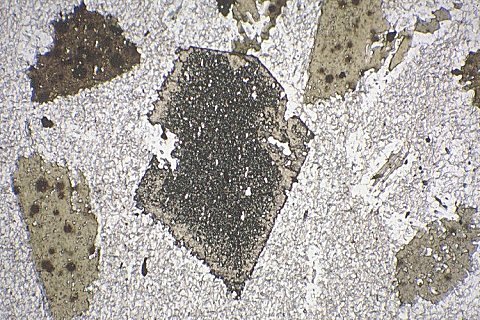
General view of upper Timeball Hill sample showing porphyroblastic and poikiloblastic texture of staurolite (centre) and biotite, and quartz-rich pseudomorphs after chloritoid. Photomicrograph in plane-polarised light, width of view 3.5 mm. [cf. Fig. 3a]
Chloritoid and its pseudomorphs
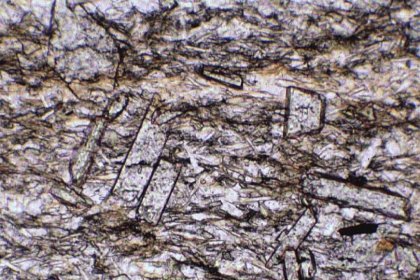
Chloritoid tablets in lower grade metapelite from the lower Timeball Hill Formation, Penge. Width of view 0.7 mm. [cf. Fig. 3b]
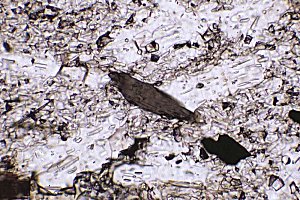
Quartz-rich pseudomorphs after chloritoid, containing slender aligned muscovite flakes. Width of view 0.8 mm. [cf. Fig. 3c]

Pseudomorph of biotite and quartz after chloritoid, from a sample collected at Annesley mine. Small high-relief aligned lenticles are chloritoid relics. Width of view 1 mm. [cf. Fig. 3d]
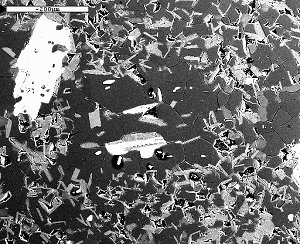
Backscattered electron image of rectangular pseudomorph confirms that the dominant replacing phase is quartz (very dark grey) and that plagioclase (equant grey grains) is confined to the matrix. Scale bar is 0.2 mm.

Andalusite poikiloblast with lath-shaped inclusion-poor domains marking where chloritoid has been replaced by andalusite during porphyroblast growth. Width of view 1.2 mm. [cf. Fig. 3e]
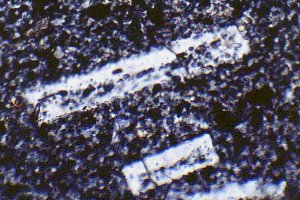
Hourglass inclusion patterns in pseudomorphed chloritoid (now andalusite). Crossed polars. Width of view 0.4 mm.
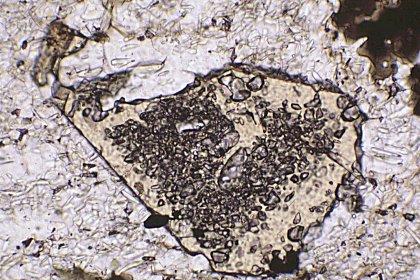
Quartz-rich pseudomorph after chloritoid wrapped by outer part of staurolite poikiloblast. Width of view 1 mm. [cf. Fig. 3f]
The interpretation of the chloritoid pseudomorphs is as follows:
- Where an aluminous porphyroblast impinged upon chloritoid, the chloritoid was directly replaced by the porphyroblast, leaving a lath-shaped inclusion-poor domain in the porphyroblast.
- Where chloritoid broke down in the matrix, away from aluminous porphyroblasts, it was replaced mainly by quartz.
- Where an aluminous porphyroblast impinged on a quartz-rich pseudomorph, it did not replace the quartz.
- The quartz-rich pseudomorphs indent only the outermost zones of andalusite and staurolite porphyroblasts, whereas the lath-shaped domains are abundant in their interiors. Therefore, chloritoid continued to be a reactant for most of the growth interval of andalusite and staurolite.
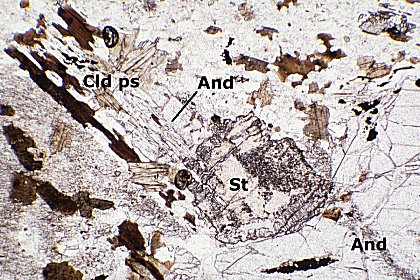
Here, a slightly lower-grade rock from Annesley mine shows similar relationships. A chloritoid pseudomorph, aligned NW-SE, is partly overgrown by staurolite and andalusite. The interpretation is: Early stages of staurolite growth (under the label "St") replaced chloritoid directly. Later stages of skeletal staurolite (left of label) grew over pseudomorphed chloritoid. Staurolite is partly enveloped by large andalusite, which could have nucleated at similar time to staurolite. Andalusite in this rock still has some chloritoid relics in its inner regions, but the outermost parts also overgrow the pseudomorphed chloritoid (where indicated).
Petrographic relationships involving staurolite
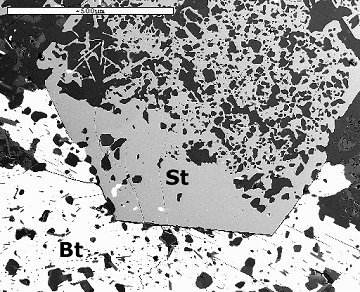
Backscattered electron image showing biotite overgrown by staurolite. The outline of the biotite and its pattern of quartz inclusions appear to be faithfully preserved by the staurolite. Scale bar is 0.5 mm. [cf. Fig. 4a]
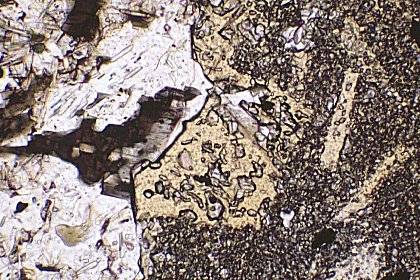
Outer parts of staurolite poikiloblasts commonly encroach upon biotite (shown by inclusion-poor domain completing the shape of the external biotite flake). These biotite replacements are not found in the geometric centres of large staurolites, where instead lath-shaped pseudomorphs after chloritoid are typical (right), implying that biotite may not have been present before staurolite appeared. Plane-polarised light. Width of view 0.9 mm. [cf. Fig. 4b]
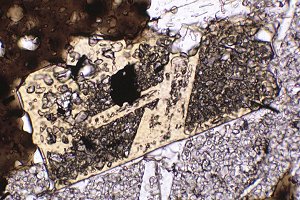
Lath-shaped domains marking former chloritoid, in staurolite (centre) which has been enveloped by andalusite. The central lath shape passes into the andalusite (below), and its upper end is continuous with a quartz-rich pseudomorph which forms a small embayment in the staurolite. The staurolite has also overgrown the edge of a biotite porphyroblast (left), and another quartz-rich pseudomorph after chloritoid is visible at the top edge. Plane-polarised light. Width of view 1 mm. [cf. Fig. 4c]
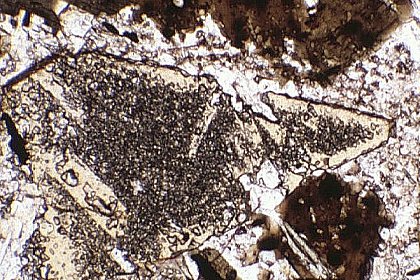
Staurolite growing in the matrix region. Note the inclusion-free rim zone around much of the perimeter. This might be expected if staurolite continues to grow right up to the thermal peak, when heating rates slow right down, but the rock remains at high T, allowing a little more local mass transfer and microstructural readjustment in the final growth interval.
Note also that chloritoid shapes occur in the core of staurolite, but quartz pseudomorphs after chloritoid project into the outline. Width of view 1.5 mm.
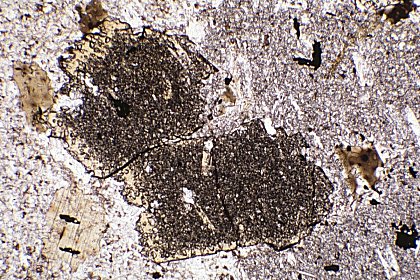
A pair of staurolite crystals partly enclosed by andalusite (right), but projecting into matrix (left). The inclusion-poor outer rims are much more strongly developed on the matrix side of the poikiloblasts. The inference is that staurolite growth probably outlasted that of andalusite. Thus, although staurolite can be found totally enclosed in staurolite, this is largely a result of the very different porphyroblast sizes. Width of view 2.5 mm. [cf. Fig. 4d]
Garnet growth
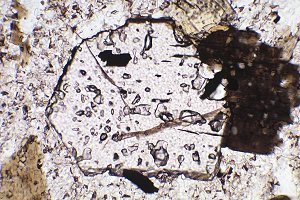
Garnet overgrowing matrix and pre-existing biotite. Former extent of biotite grain is marked by change from small rounded quartz inclusions to small aligned opaque platelets with scattered larger quartz inclusions. Plane-polarised light. Width of view 1.2 mm. [cf. Fig. 4e]
Cordierite growth and breakdown
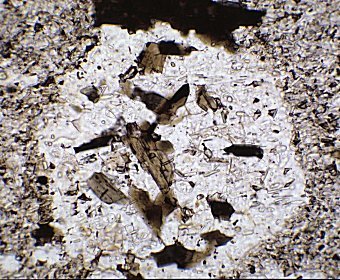
Hexagonal pseudomorph of quartz, biotite and muscovite after cordierite. Cordierite porphyroblasts of identical habit are seen in more Mg-rich samples from the overlying Boven Shale. Width of view 1 mm. [cf. Fig. 4f]
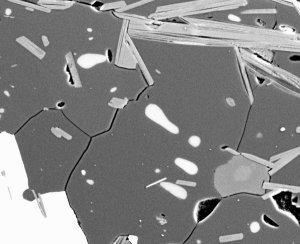
Backscattered electron image showing small oval cordierite relics (bright) within quartz (dark) in pseudomorph. Width of view 0.2 mm. [cf. Fig. 4g]
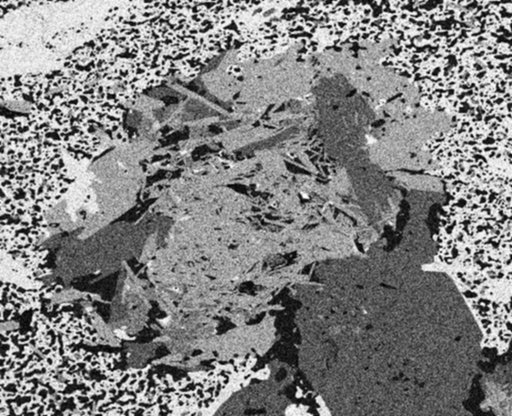
X-ray composition map for Al showing pseudomorph after cordierite wholly enclosed by andalusite (bright spongy material). The dominant phase in the pseudomorph is muscovite (medium grey) with some biotite (dark grey) and minor quartz (black). Width of view 1.4 mm. [cf. Fig. 4h]

